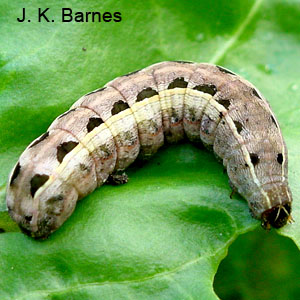Southern armyworm
Order: Lepidoptera
Family: Noctuidae
Genus and species: Spodoptera eridania (Stoll)
The southern armyworm appears to be increasing in importance as a pest in some southern states, but it seems to have relatively minor impact in Arkansas. The caterpillars have been reported to feed on a broad range of plants, including important vegetable, fruit, field, and ornamental crops. They also consume weeds, especially pigweed and pokeweed, and there are reports of armyworm infestations beginning with these weeds and subsequently spreading to adjacent crops. Young larvae feed gregariously, often skeletonizing host plants. Larvae become solitary as they mature. They are known to bore into fruit, often damaging tomato crops. The southern armyworm is native to topical areas of North, Central, and South America. It is common in the southeastern states, but it has been found as far north as northern Arkansas and Kansas. Larvae are variable in color and can be green gray or black. They have a pair of lighter dorsolateral stripes with prominent, adjacent black scallops on most body segments. They pupate in soil to a depth of 2–4 inches. Adults have gray or brown forewings with irregular markings and white hindwings. Eggs are laid in clusters and covered with scales from the female’s body. In warm climates, the southern armyworm can have four to five generations per year.

